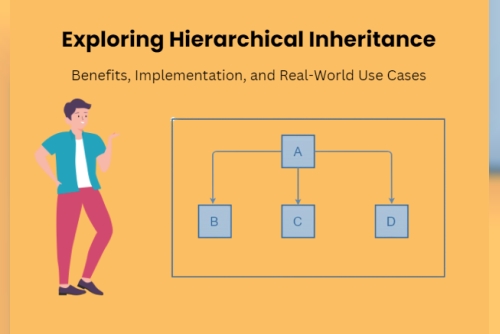Inheritance is a fundamental concept in object-oriented programming (OOP), enabling the creation of new classes based on existing ones. This promotes code reuse, modularity, and easier maintenance. Among the various types of inheritance, hierarchical inheritance stands out as a popular and effective approach.
Hierarchical inheritance occurs when multiple subclasses inherit from a single superclass. The parent class, situated at the top of the hierarchy, provides common properties and methods that the child classes share. These subclasses can extend or override the inherited features to add their own unique attributes or behaviors. This inheritance model is ideal when multiple entities share common characteristics but also require specialized functionalities.
For example, in a vehicle system, a Vehicle class could serve as the parent class. Subclasses like Car, Truck, and Bike could inherit attributes such as speed, engineType, and fuelCapacity from the Vehicle class while introducing their own unique properties, such as numberOfDoors for a car or payloadCapacity for a truck.
Code Reusability
A key benefit of hierarchical inheritance is its promotion of code reuse. Subclasses inherit common properties and methods from the parent class, eliminating the need to redefine these elements repeatedly. This not only reduces redundancy but also makes the code more efficient.
Structured Code Organization
Hierarchical inheritance helps organize code logically by establishing a parent-child relationship between classes. This structure is especially useful in larger, more complex systems where different entities share common behavior. It simplifies the overall design, making the system easier to manage and extend.
Ease of Maintenance
With hierarchical inheritance, changes made to the parent class automatically apply to the child classes. This feature streamlines maintenance since any modification to shared methods or attributes only needs to be made in one place, ensuring consistency across subclasses.
Flexibility
Hierarchical inheritance allows for creating specialized subclasses without modifying the parent class. Each subclass can add its own unique properties and methods while still benefiting from the shared attributes of the superclass. This flexibility ensures that the system remains scalable and can be expanded with new features without disrupting the overall design.
Improved Readability and Simplicity
By clearly defining parent-child relationships, hierarchical inheritance enhances the readability of the code. It makes the system easier to understand for other developers and promotes better collaboration. This clarity is crucial when the codebase is being worked on by multiple developers or teams.
How Hierarchical Inheritance Works
While we won’t go into code details here, the basic implementation of hierarchical inheritance involves the following steps:
Define the Superclass:
The parent class is created with common attributes and methods that will be shared by all subclasses. This class serves as the foundation for all related entities.
Create Subclasses:
Subclasses are defined by inheriting from the superclass. These subclasses can add specialized properties and methods while retaining the features inherited from the parent class.
Override Methods (if necessary):
If a subclass needs to provide a specific implementation of a method inherited from the parent class, it can override that method. This customization ensures that the subclass behaves as required while still adhering to the structure defined by the superclass.
Instantiate Objects:
After the classes are defined, objects can be created from both the parent class and its subclasses. The objects created from subclasses inherit the properties and methods of the parent class automatically.
Real-World Examples of Hierarchical Inheritance
Vehicle System
A classic use case of hierarchical inheritance is in vehicle systems. A Vehicle superclass can define common properties like speed, color, and fuelType. Subclasses such as Car, Truck, and Motorcycle can inherit these attributes while adding their own specific details, such as numberOfSeats for cars or cargoCapacity for trucks. This structure allows for shared behavior across different vehicle types while still accommodating their distinct features.
Animal Classification
In biological systems, animals are categorized based on shared traits. A superclass Animal might include general properties like age, weight, and habitat. Subclasses like Mammal, Bird, and Fish can inherit these common attributes while adding specialized features, such as furType for mammals or wingSpan for birds. This hierarchical approach mirrors the natural classification system, providing clarity and structure to the code.
Employee Management System
In an organizational context, a Employee superclass could contain common attributes such as name, employeeID, and salary. Subclasses like Manager, Developer, and HR can inherit these properties and introduce role-specific details. For example, Manager might include teamSize, while Developer could define programmingLanguages. This inheritance model is effective for handling different types of employees while maintaining a clean structure in the code.
Educational Institutions
In an educational setting, a Person superclass can define attributes like name, address, and contactNumber. Subclasses like Student, Teacher, and Staff inherit these details and introduce unique properties. For instance, Student might have enrollmentNumber, while Teacher could add subjectSpecialization. Hierarchical inheritance helps model real-world roles within educational institutions efficiently.
E-commerce Product Catalog
In an e-commerce system, a Product superclass might define common properties such as productID, price, and category. Subclasses like Electronics, Clothing, and Books inherit these properties while adding specific details. For example, Electronics could introduce warrantyPeriod, while Clothing might define size and materialType. This structure streamlines the management of different product types in an online store.
Challenges and Considerations
While hierarchical inheritance offers several benefits, it’s important to be aware of potential challenges:
Tight Coupling
Hierarchical inheritance can lead to tight coupling between classes. If the parent class undergoes significant changes, it could affect all its subclasses, making the system harder to modify without breaking existing functionality.
Limited Flexibility
In some cases, hierarchical inheritance may not be flexible enough to handle all scenarios. If a subclass doesn’t align well with the parent class’s behavior, it can cause issues, forcing developers to either refactor the class structure or introduce workarounds.
Overuse of Inheritance
Excessive reliance on inheritance can result in a complex, hard-to-maintain codebase. In some situations, composition (having objects within objects) may be a better approach, offering more flexibility without the drawbacks of deep inheritance hierarchies.
Conclusion
Hierarchical inheritance is a powerful OOP concept that fosters code reuse, improves system organization, and simplifies maintenance. Its real-world applications, from vehicle systems to employee management, highlight its versatility across different domains. However, like any design pattern, it should be used thoughtfully to avoid tight coupling and excessive complexity. By understanding its benefits and challenges, developers can effectively leverage hierarchical inheritance to build scalable and maintainable systems.
















